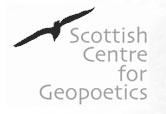The Practice of Geopoetics
Some very personal reflections on published works by Jim McCarthy.
Commencing my 8th published book, I am aware of the very tenuous connections these works have with geopoetics per se – but I am comforted by the notion that people come to geopoetics from very different interests. Definitions are less important than living in the world as a ‘poetic inhabitant of the earth.’
Wild Scotland and An Inhabited Solitude: Scotland Land and People were closest to the geopoetical theme being concerned with the environment of Scotland, specifically the natural heritage, the latter a word much narrower than the Gaelic dualchas (now in the Gaelic version of the title of Scottish Natural Heritage) which also embraces ancestry, homeland, and personal place. I became increasingly aware that my old organisation, the Nature Conservancy Council, and possibly its successor, SNH, sometimes came to grief because of a failure to appreciate that ‘scientific’ arguments did not always garner the support of local communities, and might indeed generate resentment.
An Inhabited Solitude was stimulated by an awareness of a lack of anything published for the general public explaining the links between land, people and conservation ethics in Scotland, while Wild Scotland was prompted by the lack of awareness of the sheer diversity of Scotland’s natural riches, based on its climate and geology, and how they could be accessed. Although both works are factual, in Solitude I indulged in a short polemic on conservation based on a common resource for the whole community, underpinned by Carlyle’s dictum that ‘the great law of culture is: let each become all that he was created capable of being’, emphasising that conservation and respect for the environment had as much to do with culture – language, art, music, literature rooted in a real sense of place – as much as with science and technology.
Studying forestry at university, my own eyes were opened to the harmonious ecological relationships between soils, vegetation and climate. But I had come to so-called ‘science’ through early experience of the countryside in the environs of a typical Scottish industrial town, Dundee, not dissimilar to that of White on the Ayrshire coast – in my case in the Angus glens. My earliest teenage memory of a geopoetic insight was encountering the great open pinewoods of Rothiemurchus, having trekked over from Glen Clova. Where White has been addicted to coastal landscapes, I have ever since been attracted by mountains and forests.
The second series of books are biographical, focussed on relatively unknown historic Scottish explorers and travellers. Several are informed by my early experience of East Africa as soldier, student and forest explorer – an area which incidentally, does not feature in White’s works. It is not surprising that it is White’s ‘waybooks’ which interest me most, since like him, I have spent some time in solo travelling over several continents. None of the main characters appear to be ‘geopoetical’ but in my last book on the early plant collector, Archibald Menzies, I describe how he wrote to his mentor Sir John Hope at the Royal Botanic Garden in Edinburgh of the tears which flowed when, in Nova Scotia, he rediscovered the joys of field collecting. Later, with George Vancouver, he was to extol the lonely beauty of the coastline of what is now British Columbia.
However, it was the distinguished cartographer, Keith Johnston, the tragic hero of my Journey into Africa who broke the shackles of traditional geography by linking climatic zones with altitudes across the world: his father of the same name had known the great Humboldt, who in his Cosmos revealed that he could not imagine natural science divorced from poetry and philosophy. Father and son, probably the most distinguished scientific cartographers of their time had a similarly open-minded culture, connecting the world of map-making with geology, oceanography, climate and natural history. Later these facets were expressed in remarkable globes.
Both Menzies and Keith Johnston are exemplars of the nomadic or wandering Scot, (which White describes) albeit with utilitarian purposes. The same could be said of the Scottish engineers, McEwan and Munro, whose intimate diaries form the basis of my Road to Tanganyika. (I was following in that purposeful tradition as a forest explorer in the early 1960s) The ultimate wanderer was the hero of Selim Aga, captured as a slave in a remote part of the Sudan, but educated in North-East Scotland who may have been the first African to travel the three great rivers of Africa – the Nile, Niger and Congo. But he pined for a cottage in Scotland, where he had written his first (and perhaps only) poems on the landscape of Deesside.
As described so eloquently in Richard Holmes’ recent Age of Wonder, scientists had started asking existential questions towards the end of the 18th century, while simultaneously the Romantic poets based some of their writings on the great scientific discoveries of the time. An excellent example was the astronomer William Herschel, (whose son John appears in my latest work on the life of Captain Basil Hall, R.N.) with his organic view of the nebulae. Hall, another Scot and amateur scientist, impressed the Professor of Geology, J. D. Forbes of St. Andrews with his analogy between volcanic eruptions and glacier streams.
Why did I choose to write about these characters? I have for long been interested in what motivates travellers and those who pushed out the boundaries, combining action with contemplation. Thus my literary heroes are R. L. Stevenson, Bruce Chatwin, Jose de Cela, Laurens van der Post, Wilfrid Thesiger, John Muir, Robert Cunninghame-Graham, Alastair Reid, Pablo Neruda and Patrick Leigh Fermor, among others. None of these would lay claim to being ‘geopoets’, but their inclinations were often in that direction. Neither would I claim this for my own published work, but my unpublished travel notes (which I describe as ‘Vagabundajes’ or ‘Transcendental Travelogues’) from Morrocco to Maine, come closer. One day, I promise to put them in some sort of order.





